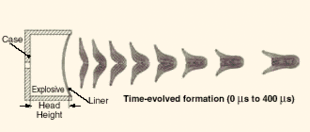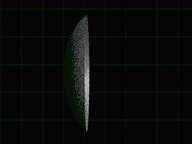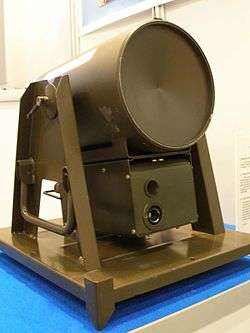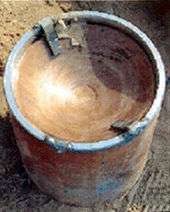Explosively formed penetrator
An explosively formed penetrator (EFP), also known as an explosively formed projectile, a self-forging warhead, or a self-forging fragment, is a special type of shaped charge designed to penetrate armor effectively. As the name suggests, the effect of the explosive charge is to deform a metal plate into a slug or rod shape and accelerate it toward a target. They were first developed as oil well perforators by American oil companies in the 1930s, and were deployed as weapons in World War II.[1][2]

Difference from conventional shaped charges


A conventional shaped charge generally has a conical metal liner that projects a hypervelocity jet of metal able to penetrate steel armour to great depths; in travel over some distance the jet breaks up along its length into particles that drift out of alignment, greatly diminishing its effectiveness in that cases.
An EFP, on the other hand, has a liner face in the shape of a shallow dish. The force of the blast moulds the liner into any of a number of shapes, depending on the shape of the plate and how the explosive is detonated.[3] Some sophisticated EFP warheads have multiple detonators that can be fired in different arrangements causing different types of waveform in the explosive, resulting in either a long-rod penetrator, an aerodynamic slug projectile, or multiple high-velocity fragments. A less sophisticated approach for changing the formation of an EFP is the use of wire-mesh in front of the liner. The mesh causes the liner to fragment into multiple penetrators.[4]
In addition to single-penetrator EFPs (also called single EFPs or SEFPs), there are EFP warheads whose liners are designed to produce more than one penetrator; these are known as multiple EFPs, or MEFPs. The liner of an MEFP generally comprises a number of dimples that intersect each other at sharp angles. Upon detonation, the liner fragments along these intersections to form up to dozens of small, generally spheroidal projectiles, producing an effect similar to that of a shotgun. The pattern of impacts on a target can be finely controlled based on the design of the liner and the manner in which the explosive charge is detonated. A nuclear-driven MEFP was apparently proposed by a member of the JASON group in 1966 for terminal ballistic missile defense.[5][6] A related device was the proposed nuclear pulse propulsion unit for Project Orion.
The (single) EFP generally remains intact and is therefore able to penetrate armour at a long range, delivering a wide spray of fragments of liner material and vehicle armour backspall into the vehicle's interior, injuring its crew and damaging other systems.[7]
As a rule of thumb, an EFP can perforate a thickness of armour steel equal to half the diameter of its charge for a copper or iron liner,[8] and armour steel equal to the diameter of its charge for a tantalum liner, whereas a typical shaped charge will go through six or more diameters.
The penetration is proportional to the density of the liner metal; tantalum 16.654 g/cm3, copper 8.960 g/cm3, iron 7.874 g/cm3. Tantalum is preferable in delivery systems that have limitations in size, like the SADARM, which is delivered by a howitzer. For other weapon systems where the size does not matter, a copper liner of double the calibre is used.
Extensive research is going on in the zone between jetting charges and EFPs, which combines the advantages of both types, resulting in very long stretched-rod EFPs for short-to-medium distances (because of the lack of aerostability) with improved penetration capability.
EFPs have been adopted as warheads in a number of weapon systems, including the CBU-97 and BLU-108 air bombs (with the Skeet submunition), the M303 Special Operations Forces demolition kit, the M2/M4 Selectable Lightweight Attack Munition (SLAM), the SADARM submunition, the Low Cost Autonomous Attack System, and the TOW-2B anti-tank missile.
An EFP 20 cm (8 inches) in diameter threw a 3 kg (7 lbs) copper slug at Mach 6, or 2,000 meters per second. (A .50-caliber bullet, among the most devastating projectiles on the battlefield, weighs less than two ounces and has a muzzle velocity of 900 meters per second.)
Use in improvised explosive devices

EFPs have been used in improvised explosive devices against armoured cars, for example[10] in the 1989 assassination of the German banker Alfred Herrhausen (attributed to the Red Army Faction),[11] and by Hezbollah in the 1990s.[12] A recent development is their widespread use in IEDs by insurgents in Iraq against coalition vehicles.[13]
The charges are generally cylindrical, fabricated from commonly available metal pipe, with the forward end closed by a concave copper or steel disk-shaped liner to create a shaped charge. Explosive is loaded behind the metal liner to fill the pipe. Upon detonation, the explosive projects the liner to form a projectile.
The effects of traditional explosions like blast-forces and metal fragments seldom disable armored vehicles, but the explosively formed solid copper penetrator is quite lethal—even to the new generation of mine-resistant vehicles (which are made to withstand an anti-tank mine), and many tanks.[14]
Often mounted on crash barriers at window level, they are placed along roadsides at choke points where vehicles must slow down, such as intersections and junctions. This gives the operator time to judge the moment to fire, when the vehicle is moving more slowly.[15]
Detonation is controlled by cable, radio control, TV or IR remote controls, or remote arming with a passive infrared sensor, or via a pair of ordinary cell phones. EFPs can be deployed singly, in pairs, or in arrays, depending on the tactical situation.
Non-circular explosively formed penetrators
Non-circular explosively formed penetrators can be formed based on modifications to the liner construction. For instance, U.S. patents 6606951[16] and 4649828[17] are non-circular in design. US6606951B1 is designed to launch multiple asymmetric explosively forged penetrators horizontally in 360 degrees. US4649828A is designed to form several clothespin shaped EFPs, increasing hit probability.
In addition, a simplified EFP (SIM-EFP) can be made using a rectangular liner, similar to a linear shaped charge or modified platter charge.[18] This design can be further modified to be similar to US4649828A with multiple cut and bent steel bars lined side by side instead of a singular liner.
Other terrorist uses
In Northern Ireland similar devices have been discovered that were developed by dissident Republican groups for intended use against the police.[19][20]
Use in Hayabusa 2
The spacecraft Hayabusa 2 carried a small carry-on impactor (SCI). It was dropped off Hayabusa 2 on to an asteroid and detonated. The explosion created a copper explosively formed penetrator, which hit the asteroid with a velocity of 2 km/s. The crater created by the impact was a target for further observations by the onboard instruments. The shaped charge consisted of 4.5 kg of plasticized HMX and a 2.5 kg copper liner.[21]
See also
- MAHEM
- High explosive anti-tank
- Misznay–Schardin effect
- Munroe effect
- TMRP-6 (landmine which uses an EFP)
- M21 mine (landmine which uses an EFP)
References
- Ismay, John (2013-10-18), "The Most Lethal Weapon Americans Faced in Iraq", At War blog, New York Times
- William P. Walters (1 October 1990). "The Shaped Charge Concept, Part III. Applications of Shaped Charges" (PDF). U.S. Army Ballistic Research Laboratory.
- "U.S. Air Force Research Laboratory description of an EFP". Archived from the original on 2006-03-16. Retrieved 2006-03-29.
- U.S. Patent 5540156: Selectable effects EFP warhead
- Explosively Produced Flechettes; JASON report 66-121, Institute for Defense Analysis, 1966
- Interview with Dr. Richard Blankenbecler http://www.aip.org/history/ohilist/5196.html
- DoD Directive 2000.19E, "Joint Improvised Explosive Device Defeat Organization (JIEDDO)", February 14, 2006
- ng.pdf, on the web, US military testing of SOFDK
- Atkinson, Rick (1 October 2007). "'There was a two-year learning curve ... and a lot of people died in those two years'". The Washington Post. Retrieved 24 December 2010.
- Stratfor, "The Imminent Spread of EFPs", April 11, 2007
- Hambling, David (July 29, 2008). "Superbomb Mystery: The Herrhausen Assassination". Wired.
- "Archived copy". Archived from the original on 2008-11-12. Retrieved 2008-11-05.CS1 maint: archived copy as title (link)
- Salon, "Surge of danger for US troops", January 22, 2007 http://www.salon.com/news/feature/2007/01/22/ieds/print.html
- "The truck the Pentagon wants and the firm that makes it - USATODAY.com". usatoday30.usatoday.com. Retrieved 2020-07-09.
- Correspondent, Sean Rayment, Defence (2006-06-24). "The precision-made mine that has 'killed 17 British troops'". ISSN 0307-1235. Retrieved 2020-07-09.
- Klein, Arnold S. "Bounding anti-tank/anti-vehicle weapon". patents.google.com/.
- "Explosively forged penetrator warhead". patents.google.com.
- "How to build your own armour killers". privat.bahnhof.se.
- "Dungannon man Patrick Carty charged over 'Iraq-style IED'". BBC News. February 13, 2012.
- Derry bomb was 'Iraq style mortar' – UTV Live News
- "Small carry-on impactor of Hayabusa2 mission". doi:10.1016/j.actaastro.2012.11.010. Cite journal requires
|journal=(help)
Further reading
- Fundamentals of Shaped Charges, W.P. Walters, J.A. Zukas, John Wiley & Sons Inc., June 1989, ISBN 0-471-62172-2
- Tactical Missile Warheads, Joseph Carleone (ed.), Progress in Astronautics and Aeronautics Series (V-155), Published by AIAA, 1993, ISBN 1-56347-067-5
- The Good Soldiers, David Finkel, Picador, 2009, ISBN 978-0-312-43002-3